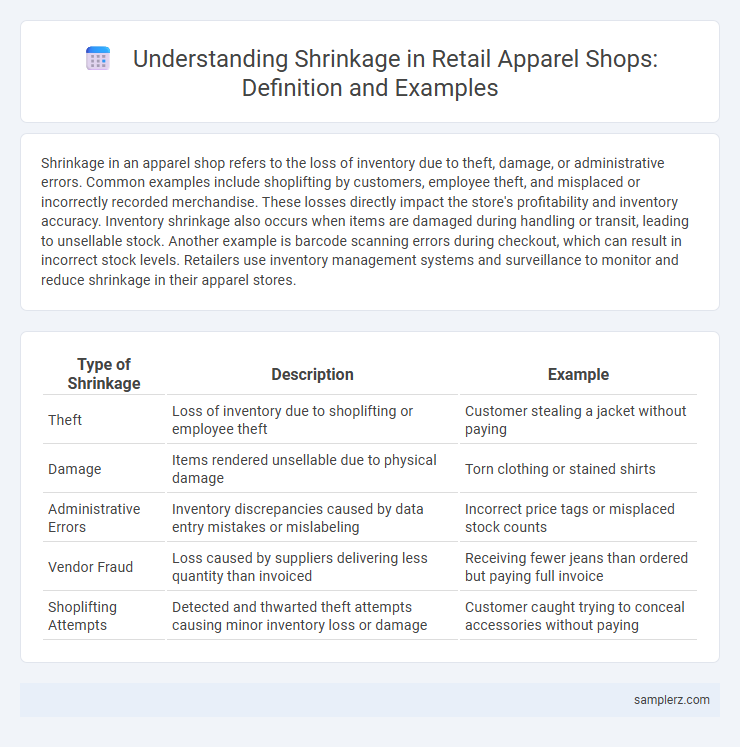Shrinkage in an apparel shop refers to the loss of inventory due to theft, damage, or administrative errors. Common examples include shoplifting by customers, employee theft, and misplaced or incorrectly recorded merchandise. These losses directly impact the store's profitability and inventory accuracy. Inventory shrinkage also occurs when items are damaged during handling or transit, leading to unsellable stock. Another example is barcode scanning errors during checkout, which can result in incorrect stock levels. Retailers use inventory management systems and surveillance to monitor and reduce shrinkage in their apparel stores.
Table of Comparison
| Type of Shrinkage | Description | Example |
|---|---|---|
| Theft | Loss of inventory due to shoplifting or employee theft | Customer stealing a jacket without paying |
| Damage | Items rendered unsellable due to physical damage | Torn clothing or stained shirts |
| Administrative Errors | Inventory discrepancies caused by data entry mistakes or mislabeling | Incorrect price tags or misplaced stock counts |
| Vendor Fraud | Loss caused by suppliers delivering less quantity than invoiced | Receiving fewer jeans than ordered but paying full invoice |
| Shoplifting Attempts | Detected and thwarted theft attempts causing minor inventory loss or damage | Customer caught trying to conceal accessories without paying |
Common Causes of Shrinkage in Apparel Stores
In apparel stores, shrinkage commonly results from shoplifting, employee theft, and administrative errors such as inaccurate inventory tracking. Damaged or misplaced merchandise during stock handling and fitting room theft also contribute significantly to inventory loss. Frequent monitoring and implementing loss prevention strategies can help reduce these shrinkage causes in retail clothing environments.
Shoplifting: A Major Source of Apparel Shrinkage
Shoplifting accounts for up to 40% of apparel shrinkage in retail stores, significantly impacting profit margins. High-value items such as branded clothing and accessories are the most targeted, with losses often exceeding $100,000 annually per store. Implementing advanced loss prevention technologies and employee training can reduce shrinkage caused by shoplifting effectively.
Employee Theft in Clothing Retail
Employee theft in clothing retail significantly contributes to shrinkage, accounting for approximately 30-40% of inventory loss. Common methods include unauthorized discounting, mislabeling items, and outright stealing of apparel during or after work hours. Implementing stringent loss prevention strategies and employee monitoring systems is crucial to mitigate financial losses caused by internal theft.
Administrative Errors Leading to Stock Discrepancies
Administrative errors such as incorrect stock entries, mislabeling of merchandise, and inaccurate inventory counts frequently lead to shrinkage in apparel shops. These discrepancies often arise from manual data input mistakes or failure to update records after returns and exchanges, causing significant differences between recorded and actual stock levels. Implementing automated inventory management systems can help minimize these errors and reduce shrinkage.
Vendor Fraud and Its Impact on Apparel Inventory
Vendor fraud in apparel retail often involves suppliers delivering fewer items than invoiced or substituting high-quality garments with inferior ones, leading to significant inventory shrinkage. This form of shrinkage erodes profit margins as retailers pay for nonexistent or substandard stock, complicating inventory management and forecasting. Detecting vendor fraud requires stringent auditing processes and real-time inventory tracking to maintain accurate apparel stock levels and protect revenue.
Fitting Room Thefts and Loss Prevention
Shrinkage in apparel retail stores frequently occurs through fitting room thefts, where customers conceal merchandise while trying on multiple items. Implementing loss prevention strategies such as monitored fitting rooms with surveillance cameras, limiting the number of items allowed inside, and training staff to observe suspicious behavior can significantly reduce inventory loss. Data shows stores with fitted room controls experience up to a 30% reduction in shrinkage rates compared to those with unmonitored changing areas.
Return Fraud in Fashion Retail
Return fraud in fashion retail significantly contributes to shrinkage, where customers exploit return policies by returning used or counterfeit apparel as new. This fraud results in substantial financial losses, with the National Retail Federation estimating return fraud accounts for approximately $17.5 billion annually in the U.S. apparel sector. Effective loss prevention strategies, such as strict return policy enforcement and digital return tracking systems, are essential to mitigate these risks.
Damaged Goods as Shrinkage in Apparel Shops
Damaged goods account for a significant portion of shrinkage in apparel shops, caused by issues such as mishandling during stocking or customer try-ons. These compromised items often become unsellable or require heavy markdowns, directly impacting inventory accuracy and profitability. Effective loss prevention strategies and staff training programs are critical to minimizing damage-related shrinkage in retail apparel environments.
Inventory Mismanagement in Clothing Stores
Inventory mismanagement in apparel shops frequently leads to shrinkage through inaccurate stock tracking and improper recording of merchandise movements. Overstocking certain sizes or styles results in unsold items that may be marked down or discarded, contributing to financial losses. Failure to conduct regular audits and reconcile physical inventory with sales records exacerbates discrepancies, impacting profitability in clothing retail.
Preventative Measures to Reduce Apparel Shrinkage
Shoplifting remains a leading cause of shrinkage in apparel stores, with an estimated 35% of losses attributed to theft. Implementing electronic article surveillance (EAS) systems and strategically placing security tags on high-value items can significantly deter potential shoplifters. Employee training on recognizing suspicious behavior and maintaining organized, well-monitored sales floors further reduces shrink incidents by improving store vigilance.

example of shrinkage in apparel shop Infographic
 samplerz.com
samplerz.com